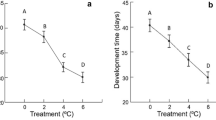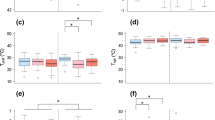Abstract
Insects with complex life cycles vary in size, mobility, and thermal ecology across life stages. We examine how differences in the capacity for thermoregulatory behavior influence geographic differences in physiological heat tolerance among egg and adult Colias butterflies. Colias adults exhibit differences in morphology (wing melanin and thoracic setal length) along spatial gradients, whereas eggs are morphologically indistinguishable. Here we compare Colias eriphyle eggs and adults from two elevations and Colias meadii from a high elevation. Hatching success and egg development time of C. eriphyle eggs did not differ significantly with the elevation of origin. Egg survival declined in response to heat-shock temperatures above 38–40 °C and egg development time was shortest at intermediate heat-shock temperatures of 33–38 °C. Laboratory experiments with adults showed survival in response to heat shock was significantly greater for Colias from higher than from lower elevation sites. Common-garden experiments at the low-elevation field site showed that C. meadii adults initiated heat-avoidance and over-heating behaviors significantly earlier in the day than C. eriphyle. Our study demonstrates the importance of examining thermal tolerances across life stages. Our findings are inconsistent with the hypothesis that thermoregulatory behavior inhibits the geographic divergence of physiological traits in mobile stages, and suggest that sessile stages may evolve similar heat tolerances in different environments due to microclimatic variability or evolutionary constraints.




Similar content being viewed by others
References
Addo-Bediako A, Chown SL, Gaston KJ (2000) Thermal tolerance, climatic variability and latitude. Proc R Soc Lond Ser B 267:739–745. doi:10.1098/rspb.2000.1065
Angilletta MJ (2009) Thermal adaptation: a theoretical and empirical synthesis. Oxford University Press, Oxford
Angilletta MJ, Zelic MH, Adrian GJ, Hurliman AM, Smith CD (2013) Heat tolerance during embryonic development has not diverged among populations of a widespread species (Sceloporus Undulatus). Conserv Physiol 1:cot018. doi:10.1093/conphys/cot018
Bonebrake TC, Boggs CL, McNally JM, Ranganathan J, Ehrlich PR (2010) Oviposition behavior and offspring performance in herbivorous insects: consequences of climatic and habitat heterogeneity. Oikos 119:927–934. doi:10.1111/j.1600-0706.2009.17759.x
Bowler K, Terblanche JS (2008) Insect thermal tolerance: what is the role of ontogeny, ageing and senescence? Biol Rev 83:339–355. doi:10.1111/j.1469-185X.2008.00046.x
Buckley LB, Kingsolver JG (2012) The demographic impacts of shifts in climate means and extremes on alpine butterflies. Funct Ecol 26:969–977. doi:10.1111/j.1365-2435.2012.01969.x
Buckley LB, Ehrenberger JC, Angilletta MJ (2015) Thermoregulatory behavior limits local adaptation of thermal niches and confers sensitivity to climate change. Funct Ecol. doi:10.1111/1365-2435.12406
Chown SL (2001) Physiological variation in insects: hierarchical levels and implications. J Insect Physiol 47:649–660. doi:10.1016/S0022-1910(00)00163-3
Diamond SE et al (2012) Who likes it hot? a global analysis of the climatic, ecological, and evolutionary determinants of warming tolerance in ants. Glob Change Biol 18:448–456. doi:10.1111/j.1365-2486.2011.02542.x
Ellers J, Boggs CL (2004) Functional ecological implications of intraspecific differences in wing melanization in Colias butterflies. Biol J Linn Soc 82:79–87. doi:10.1111/j.1095-8312.2004.00319.x
García-Barros E (2000) Egg size in butterflies (Lepidoptera: papilionoidea and Hesperiidae): a summary of data. J Res Lepidoptera 35:90–136
Grambsch TMTaPM (2014) Modeling survival data: extending the cox model. R package version 2.37-7 http://CRAN.R-project.org/package=survival
Hayes JL (1980) Some Aspects of the Biology of the Developmental Stages of Colias alexandra (Pieridae). J Lepidopterists Soc 34(4): 345–352
Hertz PE (1981) Adaptation to altitude in two West Indian Anoles (Reptilia). J Zool 195:25–37. doi:10.1111/j.1469-7998.1981.tb01891.x
Higgins JK (2014) Rapid evolution and population divergence in response to environmental change in Colias butterflies. PhD, University of North Carolina at Chapel Hill, Chapel Hill
Higgins JK, MacLean HJ, Buckley LB, Kingsolver JG (2014) Geographic differences and microevolutionary changes in thermal sensitivity of butterfly larvae in response to climate. Funct Ecol 28:982–989. doi:10.1111/1365-2435.12218
Hodkinson ID (2005) Terrestrial insects along elevation gradients: species and community responses to altitude. Biol Rev 80:489–513. doi:10.1017/S1464793105006767
Huey RB, Hertz PE, Sinervo B (2003) Behavioral drive versus behavioral inertia in evolution: a null model approach. Am Nat 161:357–366. doi:10.1086/346135
IPCC, Field CB, Barros VR, Dokken DJ, Mach KJ, Mastrandrea MD, Bilir TE, Chatterjee M, Ebi KL, Estrada YO, Genova RC, Girma B, Kissel ES, Levy AN, MacCracken S, Mastrandrea PR, White LL (2014) Ipcc climate change 2014: impacts, adaptation, and vulnerability. Part A: global and sectoral aspects. In: Field CB, Barros VR, Dokken DJ, Mach KJ, Mastrandrea MD, Bilir TE, Chatterjee M, Ebi KL, Estrada YO, Genova RC, Girma B, Kissel ES, Levy AN, MacCracken S, Mastrandrea PR, White LL (eds) Contribution of Working Group II to the Fifth Assessment Report of the Intergovernmental Panel on Climate Change. Cambridge University Press, Cambridge, New York
Kingsolver JG, Buckley LB (2015) Climate variability slows evolutionary responses of Colias butterflies to recent climate change. Proc R Soc B. doi:10.1098/rspb.2014.2470
Kingsolver JG (1983) Ecological significance of flight activity in Colias butterflies: Implications for reproductive strategy and population structure. Ecol 64:545–551
Kingsolver JG, Moffat RJ (1982) Thermoregulation and the determinants of heat transfer in Colias butterflies. Oecologia 53:27–33. doi:10.1007/BF00377132
Kingsolver JG, Watt WB (1984) Mechanistic constraints and optimality models: thermoregulatory strategies in Colias butterflies. Ecol 65: 1835–1839
Kingsolver JG, Arthur Woods H, Buckley LB, Potter KA, MacLean HJ, Higgins JK (2011) Complex life cycles and the responses of insects to climate change. Integr Comp Biol 51:719–732. doi:10.1093/icb/icr015
Krebs RA, Loeschcke V (1995) Resistance to thermal stress in preadult Drosophila buzzatii: variation among populations and changes in relative resistance across life stages. Biol J Linn Soc 56:517–531. doi:10.1111/j.1095-8312.1995.tb01108.x
Levy O et al (2015) Resolving the life cycle alters expected impacts of climate change. Proc R Soc Lond B. doi:10.1098/rspb.2015.0837
Loeschcke V, Krebs R, Dahlgaard J, Michalak P (1997) High-temperature stress and the evolution of thermal resistance in Drosophila. In: Bijlsma R, Loeschcke V (eds) Environmental stress, adaptation and evolution, vol 83. Birkhäuser, Basel, pp 175–190
Marais E, Terblanche JS, Chown SL (2009) Life stage-related differences in hardening and acclimation of thermal tolerance traits in the kelp fly, Paractora dreuxi (Diptera, Helcomyzidae). J Insect Physiol 55:336–343. doi:10.1016/j.jinsphys.2008.11.016
Mitchell KA, Sinclair BJ, Terblanche JS (2013) Ontogenetic variation in cold tolerance plasticity in Drosophila: is the Bogert effect bogus? Naturwissenschaften 100:281–284. doi:10.1007/s00114-013-1023-8
Pincebourde S, Woods HA (2012) Climate uncertainty on leaf surfaces: the biophysics of leaf microclimates and their consequences for leaf-dwelling organisms. Funct Ecol 26:844–853. doi:10.1111/j.1365-2435.2012.02013.x
Pinheiro J, Bates D, DebRoy S, Sarkar D and R Core Team (2014) Nlme: linear and nonlinear mixed effects models. R package version 3.1-117 http://CRAN.R-project.org/package=nlme
Potter K, Davidowitz G, Woods HA (2009) Insect eggs protected from high temperatures by limited homeothermy of plant leaves. J Exp Biol 212:3448–3454. doi:10.1242/jeb.033365
Potter KA, Davidowitz G, Arthur Woods H (2011) Cross-stage consequences of egg temperature in the insect Manduca sexta. Funct Ecol 25:548–556. doi:10.1111/j.1365-2435.2010.01807.x
Potter KA, Arthur Woods H, Pincebourde S (2013) Microclimatic challenges in global change biology. Glob Change Biol 19:2932–2939. doi:10.1111/gcb.12257
R Core Team (2013) R: a language and environment for statistical computing. R Foundation for Statistical Computing, Vienna. http://www.R-project.org/
Radchuk V, Turlure C, Schtickzelle N (2013) Each life stage matters: the importance of assessing the response to climate change over the complete life cycle in butterflies. J Anim Ecol 82:275–285. doi:10.1111/j.1365-2656.2012.02029.x
Rawlins JE (1980) Thermoregulation by the black swallowtail butterfly, Papilio Polyxenes (Lepidoptera: Papilionidae). Ecology. doi:10.2307/1935193
Sarup P, Sørensen JG, Dimitrov K, Barker J, Loeschcke V (2006) Climatic adaptation of Drosophila buzzatii populations in Southeast Australia. Heredity 96:479–486. doi:10.1038/sj.hdy.6800828
Sherman PW, Watt WB (1973) The thermal ecology of some Colias butterfly larvae. J Comp Physiol 83:25–40. doi:10.1007/BF00694570
Shirai Y (2000) Temperature tolerance of the diamondback moth, Plutella Xylostella (Lepidoptera: Yponomeutidae) in tropical and temperate regions of Asia. Bull Entomol Res 90:357–364. doi:10.1017/S0007485300000481
Sinclair BJ, Ferguson LV, Salehipour-shirazi G, MacMillan HA (2013) Cross-tolerance and cross-talk in the cold: relating low temperatures to desiccation and immune stress in insects. Integr Comp Biol. doi:10.1093/icb/ict004
Springer P, Boggs CL (1986) Resource Allocation to oocytes: heritable variation with altitude in Colias philodice eriphyle (Lepidoptera). Am Nat 127:252–256. http://www.jstor.org/stable/2461354
Sunday JM, Bates AE, Dulvy NK (2011) Global analysis of thermal tolerance and latitude in ectotherms. Proc R Soc B 278:1823–1830. doi:10.1098/rspb.2010.1295
Sunday JM et al (2014) Thermal-safety margins and the necessity of thermoregulatory behavior across latitude and elevation. Proc Natl Acad Sci 111:5610–5615. doi:10.1073/pnas.1316145111
Watt WB (1968) Adaptive significance of pigment polymorphisms in Colias butterflies. I. Variation of melanin pigment in relation to thermoregulation. Evolution 22:437–458. doi:10.2307/2406873
Watt WC, France, Snyder L, Watt A, Rothschild D (1977) Population structure of pierid butterflies. Oecologia 27:1–22. doi:10.1007/bf00345682
Williams JW, Jackson ST, Kutzbacht JE (2007) Projected distributions of novel and disappearing climates by 2100 AD. Proc Natl Acad Sci USA 104:5738–5742. doi:10.1073/pnas.0606292104
Woods AH, Bonnecaze RT (2006) Insect eggs at a transition between diffusion and reaction limitation: temperature, oxygen, and water. J Theor Biol 243:483–492. doi:10.1016/j.jtbi.2006.07.008
Acknowledgments
We thank the City of Gunnison, the City of Montrose, and Robert and Roxanne Lane of Dayspring Farms for access to collection sites. We also thank the Rocky Mountain Biological Laboratory for access to lab space. We thank Kati Moore for her tireless work with the egg thermal gradient and Edward Shin for the countless hours scoring egg-hatching videos. We thank Kate Augustine, Samuel Shuford, and Autumn Arciero for help with field experiments. We also thank the reviewers and Rob Dunn for useful edits on the manuscript. The research was supported in part by NSF Grants DEB-1120062 to L. B. B. and J. G. K. and IOS-1120500 to J. G. K.
Author contribution statement
H. J. M., L. B. B., and J. G. K. conceived and designed the experiments. H. J. M. and J. K. H. performed the experiments. H. J. M. and J. G. K. analyzed the data. H. J. M. and J. G. K. wrote the manuscript; other authors provided editorial advice.
Author information
Authors and Affiliations
Corresponding author
Additional information
Communicated by Roland A. Brandl.
Rights and permissions
About this article
Cite this article
MacLean, H.J., Higgins, J.K., Buckley, L.B. et al. Geographic divergence in upper thermal limits across insect life stages: does behavior matter?. Oecologia 181, 107–114 (2016). https://doi.org/10.1007/s00442-016-3561-1
Received:
Accepted:
Published:
Issue Date:
DOI: https://doi.org/10.1007/s00442-016-3561-1




